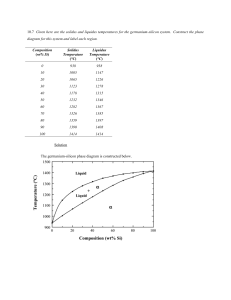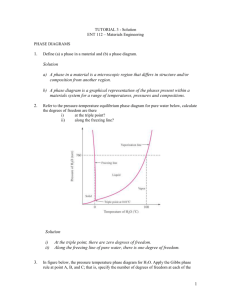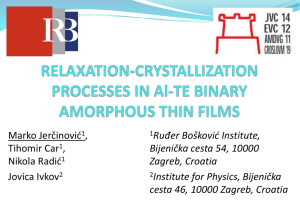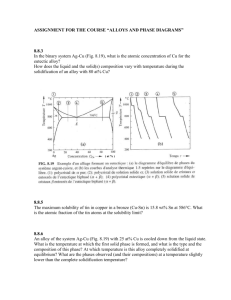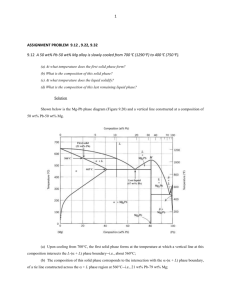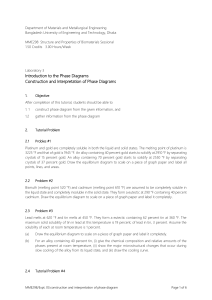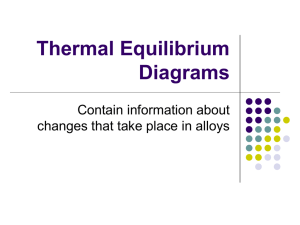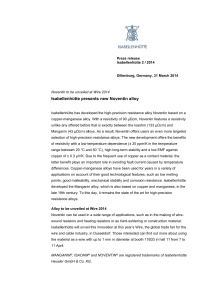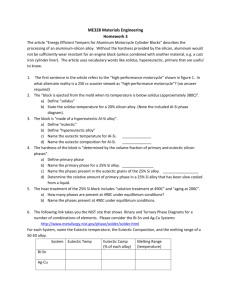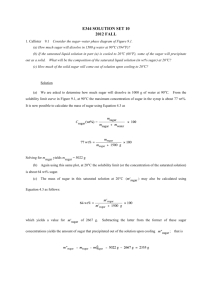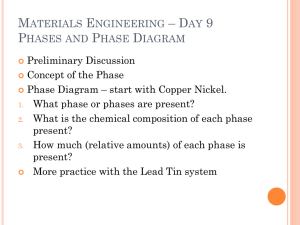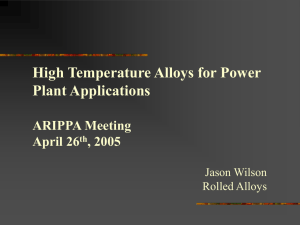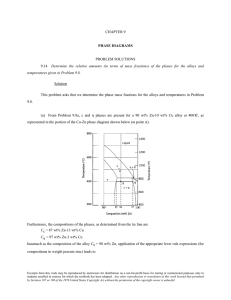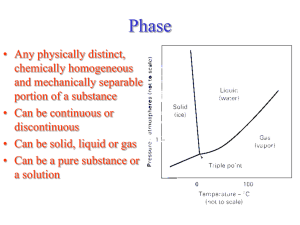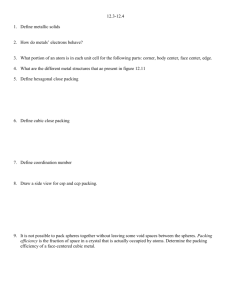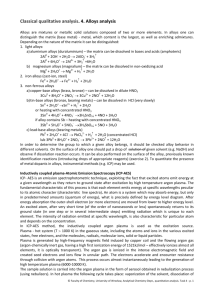10.7 Given here are the solidus and liquidus temperatures for the
advertisement
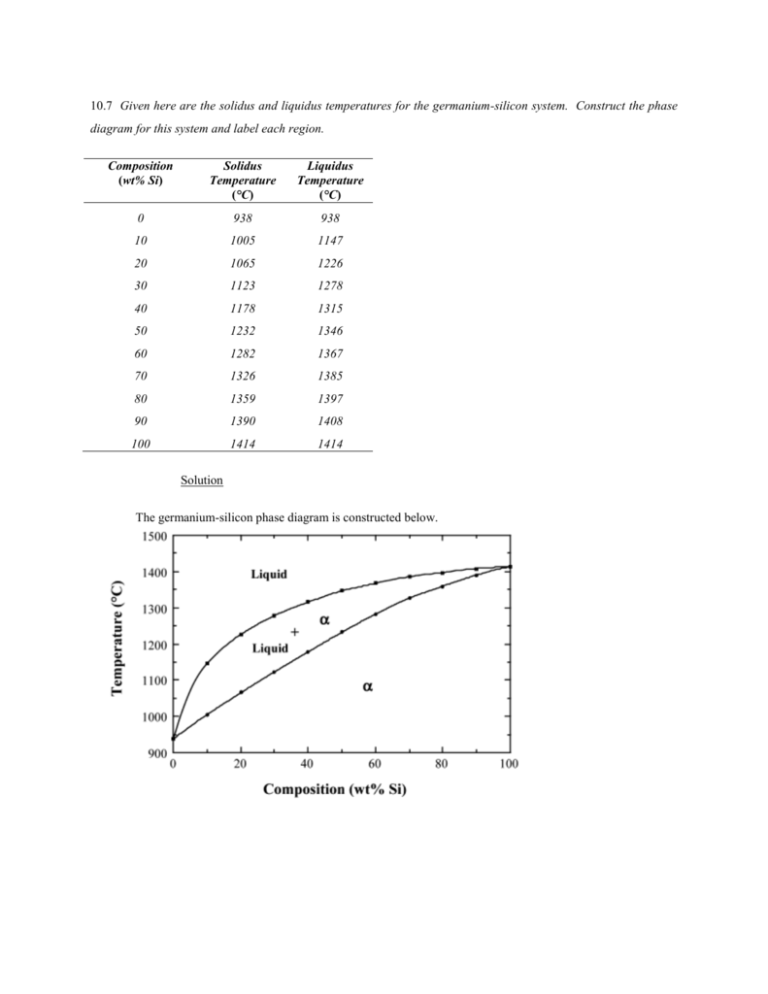
10.7 Given here are the solidus and liquidus temperatures for the germanium-silicon system. Construct the phase diagram for this system and label each region. Composition (wt% Si) Solidus Temperature (°C) Liquidus Temperature (°C) 0 938 938 10 1005 1147 20 1065 1226 30 1123 1278 40 1178 1315 50 1232 1346 60 1282 1367 70 1326 1385 80 1359 1397 90 1390 1408 100 1414 1414 Solution The germanium-silicon phase diagram is constructed below. 10.8 Cite the phases that are present and the phase compositions for the following alloys: (a) 90 wt% Zn-10 wt% Cu at 400C (750F) (b) 75 wt% Sn-25 wt% Pb at 175C (345F) (c) 55 wt% Ag-45 wt% Cu at 900C (1650F) (d) 30 wt% Pb-70 wt% Mg at 425C (795F) 10.9 Is it possible to have a copper–nickel alloy that, at equilibrium, consists of a liquid phase of composition 20 wt% Ni–80 wt% Cu and also an phase of composition 37 wt% Ni–63 wt% Cu? If so, what will be the approximate temperature of the alloy? If this is not possible, explain why. Solution It is not possible to have a Cu-Ni alloy, which at equilibrium, consists of a liquid phase of composition 20 wt% Ni-80 wt% Cu and an phase of composition 37 wt% Ni-63 wt% Cu. From Figure 10.3a, a single tie line does not exist within the + L region that intersects the phase boundaries at the given compositions. At 20 wt% Ni, the L-( + L) phase boundary is at about 1200C, whereas at 37 wt% Ni the (L + )- phase boundary is at about 1230C. 10.11 A copper-nickel alloy of composition 70 wt% Ni-30 wt% Cu is slowly heated from a temperature of 1300 C (2370F). (a) At what temperature does the first liquid phase form? (b) What is the composition of this liquid phase? (c) At what temperature does complete melting of the alloy occur? (d) What is the composition of the last solid remaining prior to complete melting? Solution Shown below is the Cu-Ni phase diagram (Figure 10.3a) and a vertical line constructed at a composition of 70 wt% Ni-30 wt% Cu. (a) Upon heating from 1300C, the first liquid phase forms at the temperature at which this vertical line intersects the -( + L) phase boundary--i.e., about 1345C. (b) The composition of this liquid phase corresponds to the intersection with the ( + L)-L phase boundary, of a tie line constructed across the + L phase region at 1345C--i.e., 59 wt% Ni; (c) Complete melting of the alloy occurs at the intersection of this same vertical line at 70 wt% Ni with the ( + L)-L phase boundary--i.e., about 1380C; (d) The composition of the last solid remaining prior to complete melting corresponds to the intersection with -( + L) phase boundary, of the tie line constructed across the + L phase region at 1380C--i.e., about 79 wt% Ni. 10.14 Determine the relative amounts (in terms of mass fractions) of the phases for the alloys and temperatures given in Problem 10.8a and b. Solution This problem asks that we determine the phase mass fractions for the alloys and temperatures in Problem 10.8. (a) From Problem 10.8a, and phases are present for a 90 wt% Zn-10 wt% Cu alloy at 400C, as represented in the portion of the Cu-Zn phase diagram shown below (at point A). Furthermore, the compositions of the phases, as determined from the tie line are C = 87 wt% Zn-13 wt% Cu C = 97 wt% Zn-3 wt% Cu Inasmuch as the composition of the alloy C0 = 90 wt% Zn, application of the appropriate lever rule expressions (for compositions in weight percent zinc) leads to W = W = C C0 C C C0 C = 97 90 = 0.70 97 87 C 90 87 = = 0.30 C 97 87 (b) From Problem 10.8b, and phases are present for a 75 wt% Sn-25 wt% Pb alloy at 175C, as represented in the portion of the Pb-Sn phase diagram shown below (at point B). Furthermore, the compositions of the phases, as determined from the tie line are C = 16 wt% Sn-84 wt% Pb C = 97 wt% Sn-3 wt% Pb Inasmuch as the composition of the alloy C0 = 75 wt% Sn, application of the appropriate lever rule expressions (for compositions in weight percent tin) leads to W = W = C C0 C C = 97 75 = 0.27 97 16 C0 C 75 16 = = 0.73 C C 97 16
